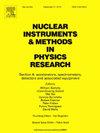Muon absorption imaging for the density structure of metro tunnel overburden
IF 1.5
3区 物理与天体物理
Q3 INSTRUMENTS & INSTRUMENTATION
Nuclear Instruments & Methods in Physics Research Section A-accelerators Spectrometers Detectors and Associated Equipment
Pub Date : 2025-02-08
DOI:10.1016/j.nima.2025.170307
引用次数: 0
Abstract
Detecting the geological structure of the overburden above subway tunnels is crucial for the safe operation of the subway. Cosmic-ray muon, due to their strong penetration capabilities, offer a non-invasive method to probe underground structures. This study leverages muon absorption imaging technology to map the geological density variations of the overburden between Shenzhen Metro's Apollo South and Yuanshan Stations. A muon detector measured muon flux at 22 points within the tunnel, which, combined with preliminary geophysical drilling data, allowed for the estimation of average densities using the differential evolution global optimization algorithm. The results show that muon flux variations corresponded well with changes in marble content within the soil, reflecting density increases from 2.08 g/cm³ to 2.27 g/cm³ between measurement points 1 to 13, and decreases to 2.03 g/cm³ at points 14 and beyond due to river erosion effects. This study confirms the efficacy of muon absorption imaging in identifying density anomalies in tunnel overburden. By integrating prior geological information, the differential evolution algorithm enhances the precision and efficiency of stratification analysis. This novel approach offers significant potential for mitigating geological hazards and ensuring subway safety, with broader applications in other underground infrastructure and continuous monitoring systems. The findings could influence future standards in subway construction and operation, highlighting the importance of innovative methods in geological assessment and infrastructure safety.
求助全文
约1分钟内获得全文
求助全文
来源期刊
CiteScore
3.20
自引率
21.40%
发文量
787
审稿时长
1 months
期刊介绍:
Section A of Nuclear Instruments and Methods in Physics Research publishes papers on design, manufacturing and performance of scientific instruments with an emphasis on large scale facilities. This includes the development of particle accelerators, ion sources, beam transport systems and target arrangements as well as the use of secondary phenomena such as synchrotron radiation and free electron lasers. It also includes all types of instrumentation for the detection and spectrometry of radiations from high energy processes and nuclear decays, as well as instrumentation for experiments at nuclear reactors. Specialized electronics for nuclear and other types of spectrometry as well as computerization of measurements and control systems in this area also find their place in the A section.
Theoretical as well as experimental papers are accepted.

 求助内容:
求助内容: 应助结果提醒方式:
应助结果提醒方式:


